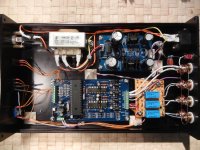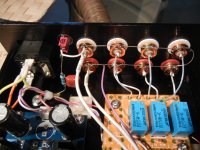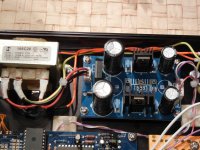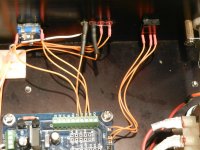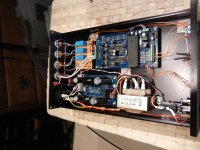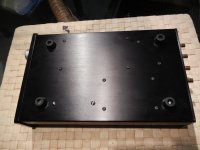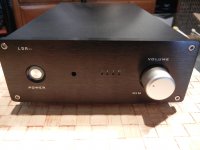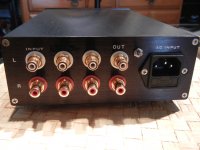Good to hear. Your's is our first customer feedback on the balanced configuration of the LDR3x. Sounded very good in our shop when we tested it but always good to know it wasn't just our imagination. Enjoy! 
Hi,
I received the kit, thanks. I have temporarily housed it in a plastic project box with very cheap and nasty phono sockets. I am delighted to report that it is clearly and unexpectedly better than my amorphous core TVC with its WBT "Next Gen" silver phono sockets. Thanks for the outstanding product!
Rob.
Hi,
I received the kit, thanks. I have temporarily housed it in a plastic project box with very cheap and nasty phono sockets. I am delighted to report that it is clearly and unexpectedly better than my amorphous core TVC with its WBT "Next Gen" silver phono sockets. Thanks for the outstanding product!
Rob.
Thanks for the review. You mentioned the name of your phono socket but not the TVC. Which TVC would that be?
Thanks,
Anand.
Good to hear. Your's is our first customer feedback on the balanced configuration of the LDR3x. Sounded very good in our shop when we tested it but always good to know it wasn't just our imagination. Enjoy!
Actually I am running it single ended right now. I ordered the balanced kit for future proofing purposes. My power amp can use balanced inputs, all I now need is a balanced source.
Thanks for the review. You mentioned the name of your phono socket but not the TVC. Which TVC would that be?
Thanks,
Anand.
Anand, it is the DIY HIFI SUPPLY amorphous, which was superior to the Sowter based one it replaced.
So just to be clear, was it the SILK brand of TVC's, or the DIYHifisupply brand of AVC's?
Thank you!
Best,
Anand.
The latter, but an early TVC version not an autotransformer (I did re-wire it to convert it to an autotransformer though). I also seem to recall that the Silks have mumetal cores.
Revised LDR3x Pricing
Having just concluded our very successful August summer sale, many of you have asked for an extension of the sale price deal.
While we can't continue the sale pricing, we've decided to reduce the base pricing for the LDR3x Master & Slave boards as follows:
$249 - LDR3x Master Board w/ Remote - Single Ended (Unbalanced)
$375 - LDR3x Master & Slave Boards w/ Remote - Balanced
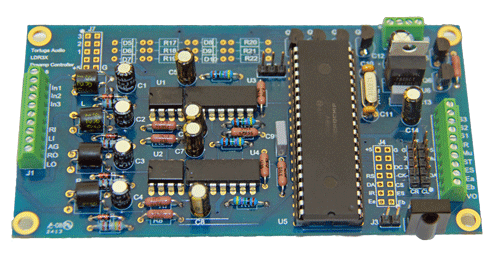

Link To Website/Store: LDR3x DIY Preamp Controller Board | Tortuga Audio
Having just concluded our very successful August summer sale, many of you have asked for an extension of the sale price deal.
While we can't continue the sale pricing, we've decided to reduce the base pricing for the LDR3x Master & Slave boards as follows:
$249 - LDR3x Master Board w/ Remote - Single Ended (Unbalanced)
$375 - LDR3x Master & Slave Boards w/ Remote - Balanced


Link To Website/Store: LDR3x DIY Preamp Controller Board | Tortuga Audio
Just wanted to share the pics of my build.
In the past I built and used numerous "Lightspeed" and "Lighter Note" attenuators - wonderful sounding but problematic units. LDR3x seems to address most of the issues related to LDR matching, impedance curve adjustment and balance, and most importantly - remote control.
Initial impressions on my newly built passive pre are very good. I am using it in front of LDM 300b amp that has very high input impedance and sensitivity, so LDR is a good match.
The build is straight forward: 28VCT Hammond transformer -> 7812 feeding LDR board, 7805 feeding input relay board. Audio signal is wired with #25 solid silver wire, everything else is wired with stranded #28 silver teflon wire. Attaching transformer and LDR board to chassis I used rubber rings to minimize vibration transfer.
The front panel houses rotary encoder, status LED, 3 inputs LED's, and IR receiver. I decided not to crowd the panel with input select and mute buttons as the rotary encoder performs all those functions.
The back panel has 3 RCA inputs, 1 output, AC connector, and ground lift switch. Normally the signal ground is not connected to common ground. However, sometimes it is necessary to have such connection to resolve some hum problems. The ground lift switch connects signal ground to chassis earth via 10 ohm resistor bypassed with 0.22 uf cap which is a simple ground loop eliminator.
NOTE: on the LDR3x board the Audio Ground connection must be connected to signal ground only, it does not connect to common ground on the board. Initially I neglected this connection which led to some mysterious behavior of the preamp. Quick call to Tortuga and a couple of emails helped to identify my mistake (Thank you Marten).
LDR3x is a big step forward in developing LDR technology for DIY community.
In the past I built and used numerous "Lightspeed" and "Lighter Note" attenuators - wonderful sounding but problematic units. LDR3x seems to address most of the issues related to LDR matching, impedance curve adjustment and balance, and most importantly - remote control.
Initial impressions on my newly built passive pre are very good. I am using it in front of LDM 300b amp that has very high input impedance and sensitivity, so LDR is a good match.
The build is straight forward: 28VCT Hammond transformer -> 7812 feeding LDR board, 7805 feeding input relay board. Audio signal is wired with #25 solid silver wire, everything else is wired with stranded #28 silver teflon wire. Attaching transformer and LDR board to chassis I used rubber rings to minimize vibration transfer.
The front panel houses rotary encoder, status LED, 3 inputs LED's, and IR receiver. I decided not to crowd the panel with input select and mute buttons as the rotary encoder performs all those functions.
The back panel has 3 RCA inputs, 1 output, AC connector, and ground lift switch. Normally the signal ground is not connected to common ground. However, sometimes it is necessary to have such connection to resolve some hum problems. The ground lift switch connects signal ground to chassis earth via 10 ohm resistor bypassed with 0.22 uf cap which is a simple ground loop eliminator.
NOTE: on the LDR3x board the Audio Ground connection must be connected to signal ground only, it does not connect to common ground on the board. Initially I neglected this connection which led to some mysterious behavior of the preamp. Quick call to Tortuga and a couple of emails helped to identify my mistake (Thank you Marten).
LDR3x is a big step forward in developing LDR technology for DIY community.
Attachments
Last edited:
Hi ClefChef
Can you confirm if the three inputs as shown in your image are switched by relays. it would seem against audio purity of signal to have relays and only 2 active series and 2 active shunt LDR's controlling 3 inputs.
I would expect for a 3 input design that there be 6 series LDR's and 2 shunts, otherwise we are back to compromises with switches, electronic or relays, which correct me if I am wrong why LDR's are used in the first place, ideally wired directly to the RCA socket
It appears impossible to have anything less than 8 LDR devices if you want 3 inputs .
Perhaps some discussion on this could be enlightening.
Cheers / Chris
Can you confirm if the three inputs as shown in your image are switched by relays. it would seem against audio purity of signal to have relays and only 2 active series and 2 active shunt LDR's controlling 3 inputs.
I would expect for a 3 input design that there be 6 series LDR's and 2 shunts, otherwise we are back to compromises with switches, electronic or relays, which correct me if I am wrong why LDR's are used in the first place, ideally wired directly to the RCA socket
It appears impossible to have anything less than 8 LDR devices if you want 3 inputs .
Perhaps some discussion on this could be enlightening.
Cheers / Chris
Hi ClefChef
Can you confirm if the three inputs as shown in your image are switched by relays. it would seem against audio purity of signal to have relays and only 2 active series and 2 active shunt LDR's controlling 3 inputs.
I would expect for a 3 input design that there be 6 series LDR's and 2 shunts, otherwise we are back to compromises with switches, electronic or relays, which correct me if I am wrong why LDR's are used in the first place, ideally wired directly to the RCA socket
It appears impossible to have anything less than 8 LDR devices if you want 3 inputs .
Perhaps some discussion on this could be enlightening.
Cheers / Chris
The 3 relays are indeed for input switching. I think "audio purity" is somewhat misplaced here. Let's keep in mind that audio signal has to travel through various interconnects, sockets, switches, soldering points, etc. so relay contacts don't affect anything.
LRD's are used in the first place not for input switching but for signal attenuation. There were some attempts by Uriah Daley to create "pure" LDR switching device, in fact the very Tortuga Audio here has LDR6 with inputs controlled by LDR's.
Silonex SR32 minimum resistance is 40 ohm so you will never have a 0 ohm shunt and some signal leakage will occur no matter what. Relays or mechanical input switching is still my preferred way of doing it.
Comparing LDR3x to other units such as Lighter Note or Lightspeed or perhaps EVA I have to say that there probably is no difference sonically, nor should there be any, - all these units share the same Silonex SR32 pairs. There are no cobalt cores, silver windings or "Virgin Blood Capacitors" involved. The difference is in the implementation of the control interface of those LDR's and Tortuga seems to have the best one so far.
The 3 relays are indeed for input switching. I think "audio purity" is somewhat misplaced here. Let's keep in mind that audio signal has to travel through various interconnects, sockets, switches, soldering points, etc. so relay contacts don't affect anything.
LRD's are used in the first place not for input switching but for signal attenuation. There were some attempts by Uriah Daley to create "pure" LDR switching device, in fact the very Tortuga Audio here has LDR6 with inputs controlled by LDR's.
Silonex SR32 minimum resistance is 40 ohm so you will never have a 0 ohm shunt and some signal leakage will occur no matter what. Relays or mechanical input switching is still my preferred way of doing it.
Comparing LDR3x to other units such as Lighter Note or Lightspeed or perhaps EVA I have to say that there probably is no difference sonically, nor should there be any, - all these units share the same Silonex SR32 pairs. There are no cobalt cores, silver windings or "Virgin Blood Capacitors" involved. The difference is in the implementation of the control interface of those LDR's and Tortuga seems to have the best one so far.
+1
Thanks for explaining the use of Relays and associated wiring used for signal switching.
In my experience the extreme OFF state resistance of LDR's creates unique opportunity to simply switch the anodes of each stereo pair. Therefore there is no need for signal switching of any kind. I certainly find this to be the most pure way of enjoying 3 inputs and Light Dependant Resistors.
Cheers / Chris .
In my experience the extreme OFF state resistance of LDR's creates unique opportunity to simply switch the anodes of each stereo pair. Therefore there is no need for signal switching of any kind. I certainly find this to be the most pure way of enjoying 3 inputs and Light Dependant Resistors.
Cheers / Chris .
Thanks for explaining the use of Relays and associated wiring used for signal switching.
In my experience the extreme OFF state resistance of LDR's creates unique opportunity to simply switch the anodes of each stereo pair. Therefore there is no need for signal switching of any kind. I certainly find this to be the most pure way of enjoying 3 inputs and Light Dependant Resistors.
Cheers / Chris .
Enjoy it, and post the schematics and build pictures of it, or maybe even create and sell a kit for DIY community. Meanwhile we continue building on the sanely priced and provided kits.
Cheers.
In my experience the extreme OFF state resistance of LDR's creates unique opportunity to simply switch the anodes of each stereo pair. Therefore there is no need for signal switching of any kind. I certainly find this to be the most pure way of enjoying 3 inputs and Light Dependant Resistors.
Cheers / Chris .
I'm a big fan of using LDRs as analog switches in lieu of mechanical switches. When LDRs are "off" they are well north of 1M of resistance - off enough! When they are full "on" they can be in the range of 40-60R which is de minimis relative to the downstream attenuator impedance. Again, on enough!
Thus, LDRs can indeed be used for selecting from multiple audio inputs. The argument for doing so is the avoidance of yet another mechanical interface point (the relay) in the signal path, gold plated contacts etc. notwithstanding. In fact, we use LDRs precisely for this purpose in our 6-input LDR6 Passive Preamp component. Including the LDR input "switch", we end up with 2 LDRs in series (1 fixed, 1 variable) and 1 in shunt (variable) per channel - or 6 total per stereo input.
Customers building their own preamps using our LDR3x DIY Passive Preamp Controller Board are left to their own devices as to how to implement input device selection. The LDR3x provides current sink switching to ground for up to 3 relays.....or LDR circuits. While we don't currently offer an input switching board, we are considering offering one in the future and it would indeed use LDRs in lieu of mechanical relays.
I would offer one caution in using LDRs as signal switches. For purposes of longevity, I don't recommend running them hard up against their LED current limit (20-25 ma in the case of the Advanced Photonix units we use) even though this yields the lowest "on" resistance. Better to back them off somewhat despite the slight rise in resistance. Still, commercial LEDs have a nominal lifetime expectancy of 50,000 hours. If you listened to music 5 hours a day, that's 10,000 days or 27 years....long enough I'd say!
Cheers!
Morten
Adding LDR input switching is like adding a mixer in front of the preamp, very low distortion mixer but not low enough. I agree it is a novel way of doing things, but sticking LDR's everywhere now that we've discovered they work work well as pot replacements seems overenthusiastic.
Just a quick review of the preamp:
Setup - ReadyNAS > SB Touch w/EDO > Schiit Bifrost Gen. 2 > LDR3x > LDM300b > Zu Omen.
After a few hours of listening to 24/96 and 24/192 flac files (jazz and classical) I have to say that LDR3x is simply outstanding passive preamp. In addition to totally transparent nature and perfect balance, it provides ease of operation that few other passives can provide, especially at this price.
Note: at this time the supplied LDR3x remote also controls Squeezebox Touch. I disabled SB IR remote with Patch Installer since I never use it, so it's not a big problem.
Setup - ReadyNAS > SB Touch w/EDO > Schiit Bifrost Gen. 2 > LDR3x > LDM300b > Zu Omen.
After a few hours of listening to 24/96 and 24/192 flac files (jazz and classical) I have to say that LDR3x is simply outstanding passive preamp. In addition to totally transparent nature and perfect balance, it provides ease of operation that few other passives can provide, especially at this price.
Note: at this time the supplied LDR3x remote also controls Squeezebox Touch. I disabled SB IR remote with Patch Installer since I never use it, so it's not a big problem.
I've been thinking of organizing a tour of our LDR based passive preamp. Perhaps for around 10 or so participants. Please let me know if you're interested.
Cheers,
Morten
Just to clarify, the tour would involve using/reviewing a finished LDR1 Passive Preamp, not the raw DIY LDR3x preamp controller board.
I've adapted the IR Remote portion of our software code to enable the use of the Apple Remote. The pic below shows the basic mapping of the Apple buttons to the functions of our Tortuga Audio remote. Since our remote has 15 buttons and the Apple remote has only 7 we had to be a bit creative to squeeze it all in there.
The one disappointment I have with the Apple Remote is its apparent inability to issue repeat commands while holding down either the Raise or Lower Volume buttons. You have to make repeated presses which for a 70 step attenuation range can be a bit annoying. In reality few of use move up and down the full volume scale so it's only a minor inconvenience but I have to wonder what Apple was thinking leaving out this easily implemented feature.
Since the Apple doesn't have individual channel input select keys, we use the Left and Right keys to switch ("roll") to the next lowest or highest input respectively. So if you're already at input #3, pressing the Right button will roll you over to Input #1. If you're at Input #2, pressing the Left button will roll you to Input #1 etc. Once you've selected the desired input, you press the Center/Enter button to lock in the change and unMute the unit.
Figuring out the Channel Balance Adjust was a bit tricky but I think we came up with a workable solution. When the unit is muted the Left and Right buttons function differently to handle balance adjustment as follows.
Pressing the Right button while Muted will switch the LDRx unit into Balance Adjust Mode as evidenced by a now rapidly blinking Status LED. While in this mode, you UnMute the unit, adjust volume as needed, and then use the Left and Right buttons to trim the channel balance. When you have the desired balance, you press the Center(Enter) button to lock in the setting. To undo any balance trim, pressing the Left button while Muted resets any previous balance adjustment to zero.
After a bit more testing to double check everything, we will probably include the Apple Remote functionality in all subsequent passive preamp units we build and ship.
We are still sorting out if we'll sell the Apple Remote as an option or in place of our Tortuga Audio remote. The Apple Remote retails for $20 and is widely available including Best Buy and numerous online stores. To the best of my knowledge you can't find it anywhere discounted. It's a very slick little bit of design.
Anyone who already has a Tortuga Audio preamp product who can't live without being able to use the Apple Remote to control it will need to get in touch with us to discuss upgrading their software. In the case of the LDR3x board, this could be done by shipping a replacement microcontroller chip with updated software. For users of our LDR1/LDR6 preamp products, you would have to ship the units back to us for this upgrade. Details on all that, including upgrade cost, to be worked out.
Any thoughts or comments welcome.
Cheers,
Morten
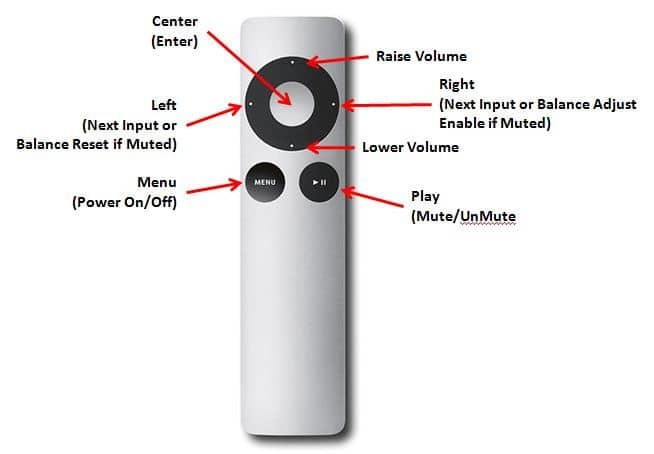
The one disappointment I have with the Apple Remote is its apparent inability to issue repeat commands while holding down either the Raise or Lower Volume buttons. You have to make repeated presses which for a 70 step attenuation range can be a bit annoying. In reality few of use move up and down the full volume scale so it's only a minor inconvenience but I have to wonder what Apple was thinking leaving out this easily implemented feature.
Since the Apple doesn't have individual channel input select keys, we use the Left and Right keys to switch ("roll") to the next lowest or highest input respectively. So if you're already at input #3, pressing the Right button will roll you over to Input #1. If you're at Input #2, pressing the Left button will roll you to Input #1 etc. Once you've selected the desired input, you press the Center/Enter button to lock in the change and unMute the unit.
Figuring out the Channel Balance Adjust was a bit tricky but I think we came up with a workable solution. When the unit is muted the Left and Right buttons function differently to handle balance adjustment as follows.
Pressing the Right button while Muted will switch the LDRx unit into Balance Adjust Mode as evidenced by a now rapidly blinking Status LED. While in this mode, you UnMute the unit, adjust volume as needed, and then use the Left and Right buttons to trim the channel balance. When you have the desired balance, you press the Center(Enter) button to lock in the setting. To undo any balance trim, pressing the Left button while Muted resets any previous balance adjustment to zero.
After a bit more testing to double check everything, we will probably include the Apple Remote functionality in all subsequent passive preamp units we build and ship.
We are still sorting out if we'll sell the Apple Remote as an option or in place of our Tortuga Audio remote. The Apple Remote retails for $20 and is widely available including Best Buy and numerous online stores. To the best of my knowledge you can't find it anywhere discounted. It's a very slick little bit of design.
Anyone who already has a Tortuga Audio preamp product who can't live without being able to use the Apple Remote to control it will need to get in touch with us to discuss upgrading their software. In the case of the LDR3x board, this could be done by shipping a replacement microcontroller chip with updated software. For users of our LDR1/LDR6 preamp products, you would have to ship the units back to us for this upgrade. Details on all that, including upgrade cost, to be worked out.
Any thoughts or comments welcome.
Cheers,
Morten

- Status
- This old topic is closed. If you want to reopen this topic, contact a moderator using the "Report Post" button.
- Home
- Vendor's Bazaar
- Tortuga Audio LDR3x DIY Preamp Controller w/ Remote
